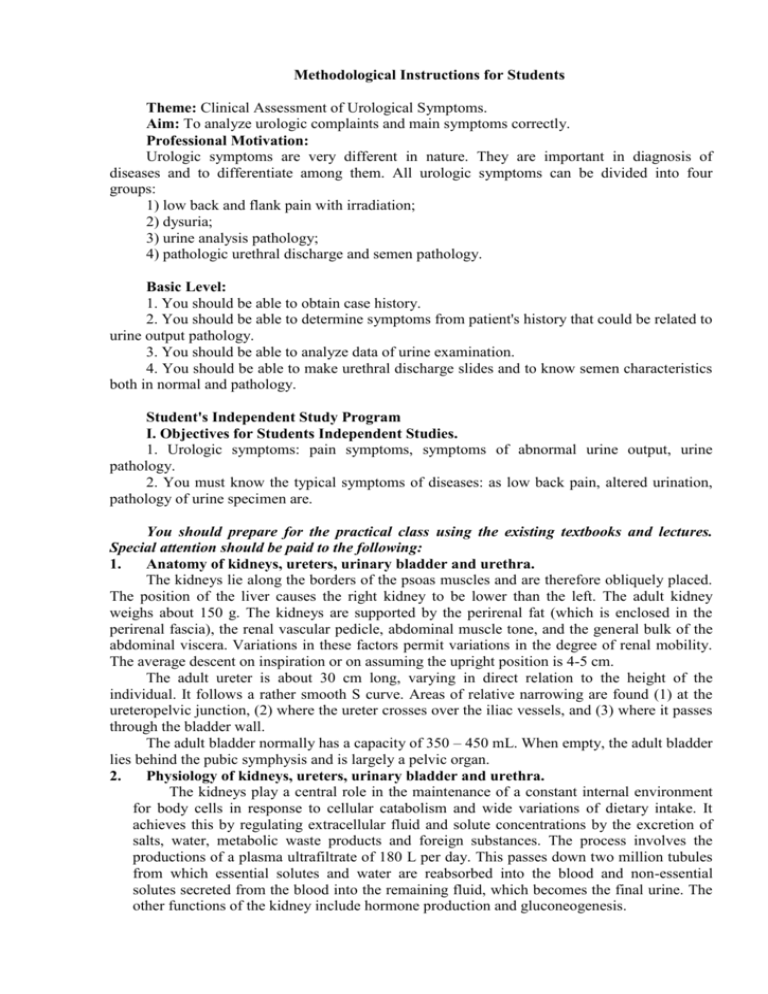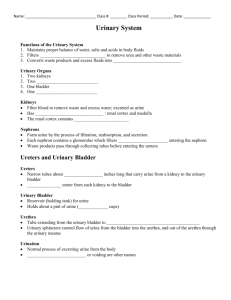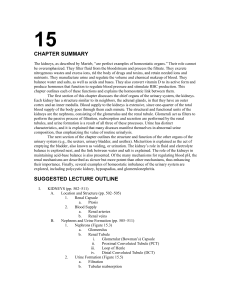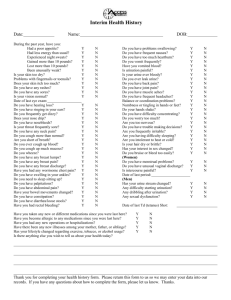Methodological Instructions to Practical Lesson
advertisement

Methodological Instructions for Students Theme: Clinical Assessment of Urological Symptoms. Aim: To analyze urologic complaints and main symptoms correctly. Professional Motivation: Urologic symptoms are very different in nature. They are important in diagnosis of diseases and to differentiate among them. All urologic symptoms can be divided into four groups: 1) low back and flank pain with irradiation; 2) dysuria; 3) urine analysis pathology; 4) pathologic urethral discharge and semen pathology. Basic Level: 1. You should be able to obtain case history. 2. You should be able to determine symptoms from patient's history that could be related to urine output pathology. 3. You should be able to analyze data of urine examination. 4. You should be able to make urethral discharge slides and to know semen characteristics both in normal and pathology. Student's Independent Study Program I. Objectives for Students Independent Studies. 1. Urologic symptoms: pain symptoms, symptoms of abnormal urine output, urine pathology. 2. You must know the typical symptoms of diseases: as low back pain, altered urination, pathology of urine specimen are. You should prepare for the practical class using the existing textbooks and lectures. Special attention should be paid to the following: 1. Anatomy of kidneys, ureters, urinary bladder and urethra. The kidneys lie along the borders of the psoas muscles and are therefore obliquely placed. The position of the liver causes the right kidney to be lower than the left. The adult kidney weighs about 150 g. The kidneys are supported by the perirenal fat (which is enclosed in the perirenal fascia), the renal vascular pedicle, abdominal muscle tone, and the general bulk of the abdominal viscera. Variations in these factors permit variations in the degree of renal mobility. The average descent on inspiration or on assuming the upright position is 4-5 cm. The adult ureter is about 30 cm long, varying in direct relation to the height of the individual. It follows a rather smooth S curve. Areas of relative narrowing are found (1) at the ureteropelvic junction, (2) where the ureter crosses over the iliac vessels, and (3) where it passes through the bladder wall. The adult bladder normally has a capacity of 350 – 450 mL. When empty, the adult bladder lies behind the pubic symphysis and is largely a pelvic organ. 2. Physiology of kidneys, ureters, urinary bladder and urethra. The kidneys play a central role in the maintenance of a constant internal environment for body cells in response to cellular catabolism and wide variations of dietary intake. It achieves this by regulating extracellular fluid and solute concentrations by the excretion of salts, water, metabolic waste products and foreign substances. The process involves the productions of a plasma ultrafiltrate of 180 L per day. This passes down two million tubules from which essential solutes and water are reabsorbed into the blood and non-essential solutes secreted from the blood into the remaining fluid, which becomes the final urine. The other functions of the kidney include hormone production and gluconeogenesis. 3. Main urologic symptoms. Systemic manifestations, local & referred pain (kidney pain, pseudorenal pain,ureteral pain, vesical pain, prostatic pain, testicular pain, epididymal pain, back & leg pain), gastrointestinal symptoms of urologic disease, symptoms related to the act of urination (frequency, nocturia, & urgency, burning sensation during urination, enuresis, symptoms of prostatic obstruction, symptoms of urethral obstruction, incontinence, oliguria & anuria, pneumaturia, cloudy urine, bloody urine), other objective manifestations (urethral discharge, skin lesions of the external genitalia, visible or palpable masses, edema, bloody ejaculation, gynecomastia, size of penis in infant or child), complaints related to sexual problems. 4. Pain in urologic pathology: character, localization, and irradiation. Typical renal pain is usually felt as a dull and constant ache in the costovertebral angle just lateral to the sacrospinalis muscle and just below the 12th rib. This pain often spreads along the subcostal area towards the umbilicus or lower abdominal quadrant. It may be expected in those renal diseases that cause sudden distention of the renal capsule. Acute pyelonephritis and acute ureteral obstruction both cause this typical pain. Such disease include cancer, chronic pyelonephritis, staghorn calculus, tuberculosis, polycystic kidney, and hydronephrosis due to mild ureteral obstruction. 5. Etiology of renal colic. The pressure within the renal pelvis is normally close to zero. When this pressure increases because of obstruction or reflux, the pelvis and calices dilate. The degree of hydronephrosis that develops depends upon the duration, degree, and site of the obstruction. The higher the obstruction, the greater the effect upon kidney. 6. Altered urination: dysuria, pollakiuria, precipitant urination, frequent urination, urinary difficulty, chronic urinary retention, paradoxical ischuria. Chronic urinary retention: this may cause little discomfort to the patent even though there is great hesitancy in starting the stream and marked reduction of its force and caliber. Constant dribbling of urine (paradoxic incontinence) may be experienced. It may be likened to water pouring over a dam. 7. Urinary incontinence. Enuresis. Incontinence (true incontinence, stress incontinence, urge incontinence, paradoxic incontinence). Strictly speaking, enuresis means bedwetting at night. It is physiologic during the first 2 or 3 years of life. 8. Acute urinary retention (etiology, treatment). Sudden inability to urinate may supervene. The patient experiences increasingly agonizing suprapubic pain associated with severe urgency and may dribble only small amounts of urine. 9. Anuria. Oliguria and anuria may be caused by acute renal failure (due to shock or dehydration), fluid-ion imbalance, or bilateral ureteral obstruction. 10) Differentiation within real urine incontinence and paradoxical incontinence, acute urine retention and anuria. 11) Proteinuria, bacteriuria (kinds). Proteinuria of any significant degree (2-4+) is suggestive of “medical” renal disease (parenchymal involvement). a) “Pathologic” proteinurias ; b) “Nonpathologic” proteinurias (physiologic, orthostatic). A presumptive diagnosis of bacterial infection may be made on the basis of results of microscopic examination of the urinary sediment. 12) Pyuria. Three-glass maneuver. In the sediment from clean-voided midstream specimen from men and those obtained by suprapubic aspiration or catheterization in women, more than 5-8 white blood cells per highpower field is generally considered abnormal (pyuria). 13) Abnormal urine specimen (altered urine output, pathological urine sediments). Patients with recurrent urolithiasis may have an underlying abnormality of excretion of calcium, uric acid, oxalate, magnesium, or citrate. 14) Hematuria (settings). Two-glass maneuver. The presence of even a few red blood cells in the urine (hematuria) is always abnormal and requires further investigation. If red blood cells predominate in the initial portion of the speciment, they are usually from the anterior urethra; those in the terminal portion are generally from the bladder neck or posterior urethra; and the presence of equal numbers of red blood cells in all containers usually indicates a source above the bladder neck (bladder, ureters, or kidneys). Key words and phrases: Pyuria, proteinuria, bacteriuria, acute urinary retention, dysuria, pollakiuria, paradoxical ischuria. II. Tests and Assignments for Self-assessment 1. Causes of renal anuria are: A. Incompatible blood transfusion. B. Shock, collapse. C. Gall-stones in ureters. D. Ureters'bandaging during gynaecologic operations. E. Nephrectomy of solitary kidney. 2. A frequent urination with normal diuresis is: A. Polyuria. B. Polydipsia. C. Pollakuria. D. Policetemia. E. Dysuria. 3. Which diurnal diuresis could be related to oliguria? A. from 250 to 500 ml. B. from 150 to 700ml. C. from 0 to 50 ml. D. from 100 to 500 ml. E. from 50 to 200 ml. 4. Which diurnal diuresis could be related to polyuria? A. over 2000 ml. B. over 3500 ml. C. 1500-2000 ml. D. 1000-1500 ml. E. over 1000ml. Multiple choice. Choose the correct answer/statement: Real life situations to be solved: 1. Patient S., at the age of 69; was admitted to the urology department, his complaints are urinary difficulty, increased urinary frequency, bloody urine. Examination: dullness of the percussion sound above the symphisis after urination. Pastematzkiy's symptom is negative. The urination is 4 times during the night. How the urinary difficulty and the urinary frequency called? How the bloody urine is called? Diseases that these symptoms are typical for. What does the dullness of the percussion sound mean? 2. Patient C., at the age of 52, was admitted at the urology department; his complained of left low back pains, absence of urine for 2 days. There is one fact from his case history: patient suffers from urolithiasis for 12 years. The operation of right side nephrectonomy 3 years ago. What is a preliminary diagnosis? How is it possible to differentiate acute urinary retention from anuria? III. Answers to the Self-assessment. The correct answers to the tests: 1. A. 2. C. 3. D. 4. A. The correct answers to the real life situations: 1. Stranguria. Hematuria. These symptoms are typical for nonmalignant hyperplasia of prostate. Chronic urinary retention. 2. Left side renal colic. Postrenal anuria. To provide catheterization of urinary bladder. Visual Aids and Material Tools: 1. Slides. 2. X-ray photographs. 3. Tables. Students Practical Activities: Students must know: 1. Anatomy and physiology of ureters, kidneys, urinary bladder, urethra. 2. Aetiology of renal colic. 3. Main symptoms of urologic diseases. 4. Altered urination. 5. Abnormal urine specimen. 6. The constants of general urine specimen examination test of Zemnitski, biochemical indicators of blood. Students should be able to: 1. Provide catheterisation of urinary bladder with rubber catheter. 2. Measure residual urine volume. 3. Determine main symptoms of urologic diseases. 4. Analyze datas from the antecedent history that could be related to altered urination. 5. Analyze datas of diagnostic tests (general urine specimen examination, urine examination by Netchyporenko, Amburge, test of Zemnitski). 6. Provide palpation and percussion of the kidneys and urinary bladder. 7. Analyze semen test in urologic pathology.







